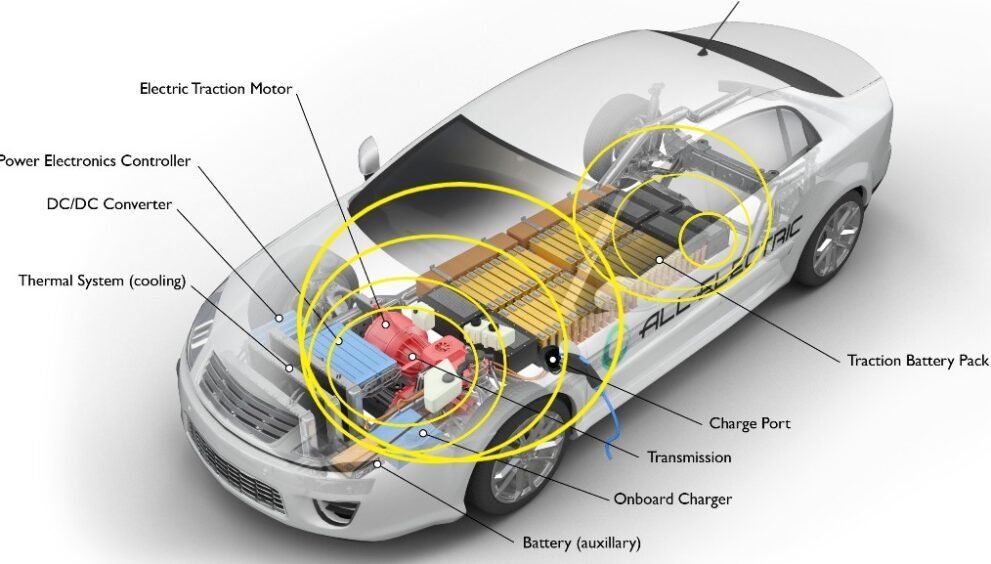EMF Electric Cars: What You Need to Know

EMF Electric Cars As you consider switching to electric vehicles, it’s essential to understand the implications of electromagnetic fields (EMF) in your daily life.

Concerns about the safety and health impacts of EMF in electric cars are on the rise. This article provides a comprehensive overview, helping you make an informed decision about your next vehicle.
You’ll learn about the causes of EMF, how electric vehicles compare to their gas-powered counterparts, and practical ways to minimize your exposure.
Key Takeaways
- Understand the implications of EMF in electric vehicles
- Learn about the causes of EMF and its health impacts
- Compare EMF exposure in electric and gas-powered vehicles
- Discover practical ways to minimize EMF exposure
- Make an informed decision about your next vehicle
Understanding EMF in Electric Cars
As you explore the world of electric vehicles, it’s essential to understand the role of electromagnetic fields (EMF) in your driving experience. Electric cars, known for their eco-friendliness and efficiency, operate using electric motors and batteries, which are sources of EMF.
What Causes Electromagnetic Fields in Electric Vehicles
Electromagnetic fields in electric vehicles are primarily generated by the electric motor, battery, and charging systems. The electric motor, being the heart of an EV, produces EMF due to the flow of electrical current. Similarly, the battery and its management system contribute to the overall EMF emissions.
How EMF Levels in Electric Cars Compare to Gas Vehicles
Research has shown that while electric vehicles do emit EMF, the levels are generally comparable to, if not lower than, those emitted by gas-powered vehicles. A study comparing EMF emissions from EVs and gas vehicles found that EVs tend to have lower EMF levels, especially when in motion.
| Vehicle Type | Average EMF Level | Maximum EMF Level |
|---|---|---|
| Electric Vehicles | 1.2 μT | 5.5 μT |
| Gas-Powered Vehicles | 1.5 μT | 7.0 μT |
Common Sources of EMF in Electric Vehicles
Common sources of EMF in EVs include the powertrain, charging equipment, and even some onboard electronics. Understanding these sources can help you better navigate the EMF landscape in your electric vehicle. For instance, the powertrain is a significant source of EMF, as it encompasses the electric motor and transmission system.
To put your mind at ease, many manufacturers are now incorporating EMF shielding technology into their designs to minimize exposure. Moreover, being aware of the sources and taking simple precautions can significantly reduce your exposure to EMF.
Protecting Yourself from EMF Exposure in Electric Vehicles
Electric vehicle owners can take several steps to minimize their EMF exposure. As the world shifts towards sustainable transportation, understanding how to reduce EMF exposure in electric cars becomes increasingly important.
EMF Shielding Technology in Modern Electric Cars
Modern electric vehicles are designed with EMF shielding technology to minimize exposure to electromagnetic fields. Manufacturers incorporate various materials and designs to effectively shield occupants from EMF. For instance, some electric cars use copper or aluminum shielding in their batteries and charging systems.

The use of EMF shielding technology is a significant step forward in making electric vehicles safer for occupants. By understanding how this technology works, you can better appreciate the efforts being made to reduce EMF exposure.
Practical Tips to Reduce Your EMF Exposure
Beyond the technology built into your vehicle, there are practical steps you can take to reduce your EMF exposure. Here are some tips:
- Limit your time near charging stations, as they can be a source of higher EMF levels.
- Use EMF-blocking products, such as phone cases and laptop sleeves, when you’re in your vehicle.
- Be mindful of your vehicle’s settings; for example, reducing the power output can lower EMF levels.
By following these tips, you can further minimize your exposure to EMF in electric vehicles.
Balancing EMF Concerns with Environmental Benefits

It’s essential to balance your concerns about EMF with the environmental benefits of driving an electric vehicle. EVs contribute to a reduction in greenhouse gas emissions and other pollutants, making them a more sustainable choice.
| Benefits | Electric Vehicles | Gas Vehicles |
|---|---|---|
| Greenhouse Gas Emissions | Lower | Higher |
| Operating Costs | Lower | Higher |
| EMF Exposure | Manageable with shielding and precautions | Varies |
By choosing an electric vehicle, you’re not only reducing your carbon footprint but also contributing to a cleaner environment. Understanding and mitigating EMF exposure allows you to enjoy the benefits of sustainable transportation while protecting your health.
Conclusion
As you navigate the world of electric vehicles, it’s clear that EMF electric cars present both opportunities and challenges. While concerns about EMF exposure are valid, the overall benefits of electric vehicles, including reduced electromagnetic pollution from electric cars, make them an attractive choice for many.
By understanding the sources of EMF in electric vehicles and taking practical steps to minimize exposure, you can enjoy the benefits of emf-free electric cars. As technology continues to evolve, advancements in EMF shielding and reduction techniques are expected.
Being informed and aware allows you to make the most of sustainable transportation options, contributing to a healthier environment and a healthier you. With the continued development of electric vehicles, the potential for reduced electromagnetic pollution electric cars becomes a significant advantage.
FAQ
Are electric cars safe from EMF emissions?
Electric cars are designed with safety in mind, and while they do emit EMF, the levels are generally comparable to or lower than those emitted by gas-powered vehicles. Many manufacturers are also incorporating EMF shielding technology to minimize exposure.
What are the common sources of EMF in electric vehicles?
The primary sources of EMF in electric vehicles include the electric motor, battery, and charging systems, as well as the powertrain, charging equipment, and some onboard electronics.
How can I reduce my EMF exposure while driving an electric car?
You can reduce your EMF exposure by limiting your time near charging stations, using EMF-blocking products, and being mindful of your vehicle’s settings. Additionally, some electric cars come equipped with EMF shielding technology.
Do electric cars emit more EMF than gas-powered vehicles?
Research has shown that electric vehicles tend to have lower EMF levels, especially when in motion, compared to gas-powered vehicles.
What is EMF shielding technology in electric cars?
EMF shielding technology in electric cars is designed to minimize exposure to electromagnetic fields. Manufacturers incorporate materials and designs that effectively shield occupants from EMF.
Are there any eco-friendly ways to reduce EMF exposure in electric cars?
Yes, choosing an electric vehicle is an eco-friendly choice that reduces greenhouse gas emissions. You can further minimize EMF exposure by using EMF-blocking products and being mindful of your vehicle’s settings.
Can I protect myself from EMF exposure while charging my electric car?
Yes, you can limit your time near charging stations and use EMF-blocking products to reduce exposure while charging your electric car.
How do I balance EMF concerns with the environmental benefits of electric cars?
By understanding and mitigating EMF exposure, you can enjoy the benefits of sustainable transportation while protecting your health. The overall benefits of electric vehicles, including reduced electromagnetic pollution and environmental impact, make them an attractive choice.




































































































































































































